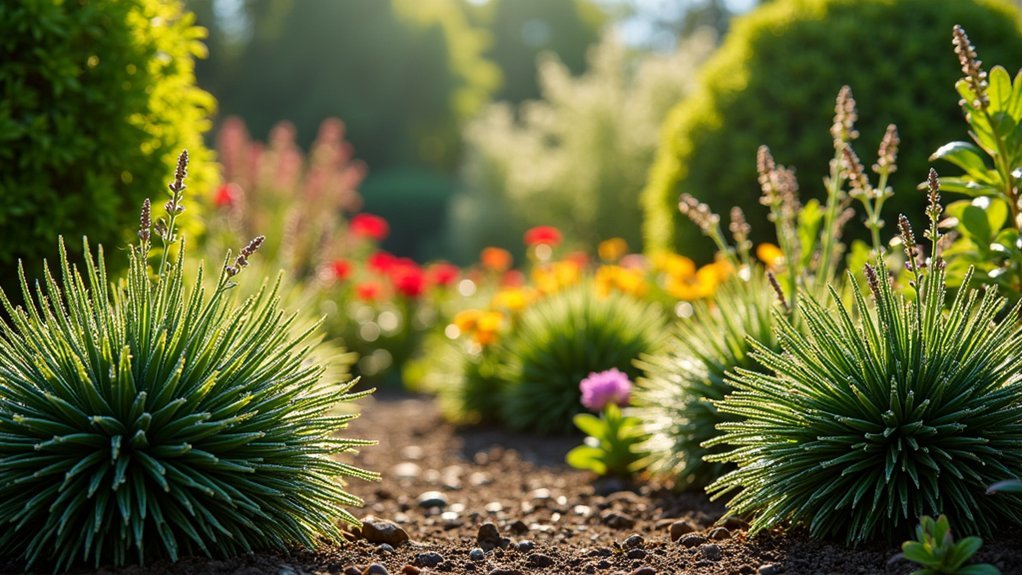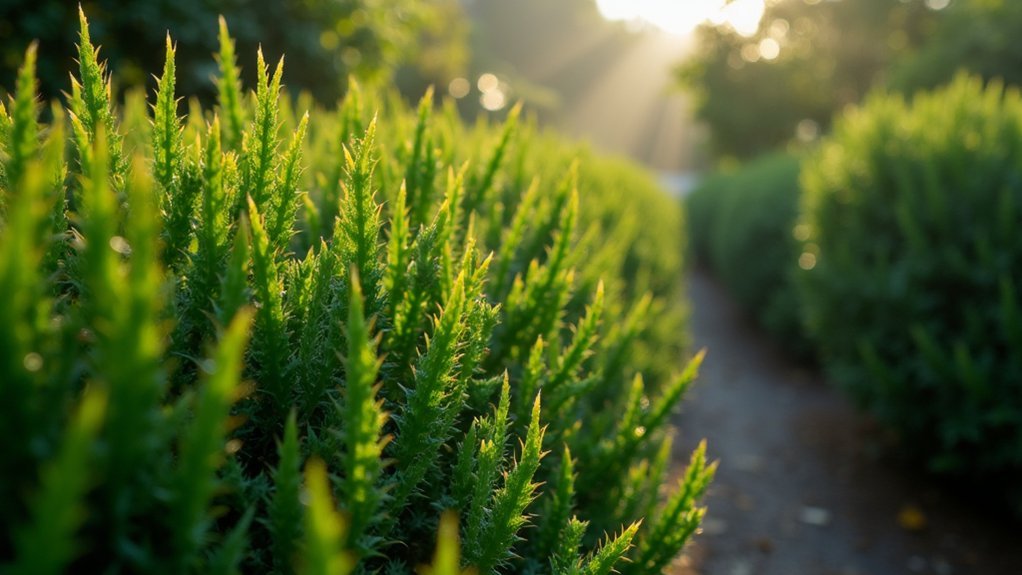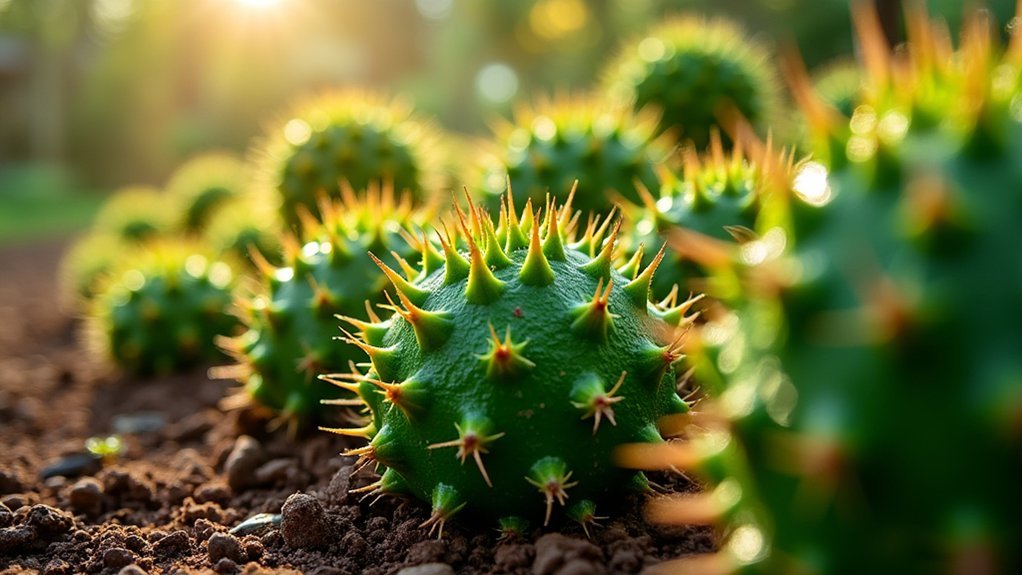Thorny shrubs in compact gardens provide natural security barriers while eliminating the need for fences. You’ll enjoy dual benefits of protection and beauty, with options like Japanese Barberry attracting pollinators and Pyracantha offering vibrant berries. They’re typically low-maintenance and adapt to various soil conditions, making them perfect for busy gardeners. Vertical varieties like climbing roses maximize limited space by transforming unused walls into functional green zones. Discover how these multi-functional plants can enhance your small garden’s security and appeal.
Security Benefits of Thorny Barriers in Small Spaces

While traditional security methods often consume valuable space, thorny shrubs offer a multifunctional alternative for compact gardens. You’ll create natural physical barriers against intruders through dense, scratchy growth that’s both effective and attractive.
Place crown of thorns beneath windows to create painful obstacles for potential intruders, while bougainvillea’s concealed thorns deter climbers attempting to scale walls or fences. These thorny shrubs also provide important ecological benefits by creating protective environments for vulnerable plant species and supporting local wildlife. These strategic plantings eliminate the need for unsightly chain-link fences and expensive alarm systems without requiring permits or zoning approvals.
Strategic thorny plantings create natural security barriers while enhancing your garden’s beauty—no permits or eyesores required.
Unlike artificial barriers that disrupt garden aesthetics, thorny perennials integrate seamlessly into your design while serving an important security purpose.
They’re particularly valuable in urban settings where space is limited but protection remains essential.
Space-Optimized Defense: Vertical Growth Solutions
For space-challenged gardens requiring security, vertical defense systems present the perfect solution by directing thorny plants upward rather than outward. By utilizing trellises and wall-mounted planters, you’ll maximize your limited area while creating effective natural barriers.
Consider climbing varieties like morning glories that naturally thrive in vertical settings. These plants develop strong root systems to anchor themselves firmly while growing upward. Pair them with a DIY trellis system for a cost-effective security measure that won’t expand your garden’s footprint. With this approach, you’re transforming unused wall space into functional green security zones.
For year-round protection, implement drip irrigation systems to maintain consistent moisture levels. This approach not only optimizes water usage but guarantees your defensive plants remain healthy and vigorous.
The additional aesthetic appeal transforms what could be merely functional into a visually striking garden feature.
Multi-Functional Thorny Plants for Limited Gardens

You’ll find that thorny plants serve dual purposes in your small garden, creating natural security barriers while taking up minimal space.
Many compact thorny varieties like Japanese Barberry also attract essential pollinators with their vibrant flowers, enhancing your garden’s biodiversity.
These space-efficient defenders can be strategically placed along property lines or vulnerable entry points, maximizing both protection and ecological benefits in limited areas. Plants like Pyracantha offer poisonous thorns that create effective security hedges while producing attractive berries.
Space-Maximizing Security Barriers
When gardening space comes at a premium, thorny plants serve double duty as both security features and beautiful landscaping elements. You’ll find several compact options that create effective barriers without sacrificing precious square footage.
| Plant | Height | Special Feature |
|---|---|---|
| Crown of Thorns | 3 feet | Ideal under windows |
| Japanese Barberry | 4-6 feet | Disease resistant |
| Firethorn | Up to 16 feet | Vibrant berries |
| Bougainvillea | Climbing | Colorful bracts |
| Agarita | 3-8 feet | Drought tolerant |
Consider placing thorny blackberry along fence lines or crown of thorns beneath vulnerable windows. The thorny rose shrub offers both protection and visual appeal with minimal footprint. For desert gardens, California cholla creates an intimidating barrier while thriving in arid conditions and tight spaces. These specialized plants have evolved sharp thorns as a survival mechanism to deter both wildlife and human intruders.
Compact Pollinator Magnets
Beyond their defensive capabilities, thorny plants in small gardens can serve as natural pollinator hubs, drawing beneficial insects while maximizing limited space.
Blackberry bushes offer a perfect example – their wild blooms attract diverse bees while providing edible fruits in a compact package.
Rose bushes combine beauty with functionality, as their fragrant flowers lure pollinators despite their protective thorns.
The vibrant blooms of bougainvillea similarly attract beneficial insects, while firethorn’s white flowers and subsequent berries support both pollinators and birds throughout the seasons.
Even the modest yellow flowers of agarita bush contribute considerably to your garden’s ecosystem.
Candy Oh Rose offers exceptional value with its continuous bloom cycle all summer long, making it an ideal choice for gardeners seeking season-long pollinator support in tight spaces.
Wildlife-Friendly Security Features in Compact Settings
Creating a secure yet wildlife-friendly garden in limited space presents a unique opportunity for urban gardeners. Thorny shrubs like roses and pyracantha serve dual purposes—they establish clear boundaries while deterring unwanted human and animal intruders.
Thorny shrubs create natural protection while transforming small urban spaces into wildlife havens.
You’ll find these prickly plants provide essential shelter for birds, protecting them from predators and offering safe nesting sites. Their dense growth forms natural hedges that maintain year-round barrier effects while defining your garden’s edges. Consider planting native species like common hawthorn that naturally support your local wildlife population.
For maximum benefit, combine these thorny defenders with other habitat elements. Incorporate varied shrub heights to create microhabitats and layer your plantings to mimic natural ecosystems.
This approach not only enhances security but also supports biodiversity by attracting beneficial wildlife while requiring minimal maintenance—perfect for your compact garden space.
Aesthetic Value Beyond Protection

Beauty intertwines with functionality when thorny shrubs grace compact gardens. Beyond their defensive qualities, these plants deliver stunning visual impact through varied textures, colors, and forms.
You’ll find English Hawthorne and Firethorn offering vibrant berries alongside delicate blooms, while Rose shrubs contribute their renowned floral displays despite their thorny nature.
These versatile plants enhance your garden’s structure and depth:
- Firethorn creates rigid, well-manicured hedges that maintain interest year-round with evergreen foliage
- Rose bushes soften hardscapes with their natural, sprawling growth pattern
- English Hawthorne thrives in poor soil conditions, displaying seasonal color changes
- Agarita integrates seamlessly with native plants, attracting winter birds with bright red berries
Strategic placement of thorny plants around vulnerable areas like first-floor windows provides natural deterrents for potential intruders.
With thoughtful selection, your thorny garden boundaries won’t just protect—they’ll captivate throughout every season.
Drought-Tolerant Defensive Options for Urban Gardens
Urban gardens face unique challenges that drought-tolerant defensive shrubs elegantly solve. Barberry and flowering quince offer robust protection with dense thorns while requiring minimal irrigation, even in sandy or compacted soils.
You’ll appreciate how these plants thrive in poor urban soil conditions—wild lilac and rockrose adapt to both alkaline and acidic environments without expensive amendments. Japanese Barberry provides excellent security with its sharp thorny barriers, making it an ideal choice for property boundaries. Their deep root systems access subsoil moisture, reducing your watering schedule considerably.
Don’t overdo fertilization; it actually weakens their drought resilience. Instead, focus on appropriate placement to maximize their defensive capabilities. Barberry’s single-node thorns and flowering quince’s prickly branches create effective barriers against both human and animal intruders.
These plants recover quickly after drought stress, with species like quince re-leafing promptly once watering resumes.
Maintaining Privacy With Narrow Thorny Hedges

Privacy concerns in compact gardens need not require bulky installations when thorny shrubs can do the job more elegantly.
You’ll find narrow thorny hedges provide exceptional privacy while taking up minimal space in your garden footprint. Holly, pyracantha, and blackthorn create dense screens that block sightlines year-round, particularly when properly pruned to maintain their compact shape. Firethorn varieties grow quickly with their thorny branches and produce attractive berries in fall while maintaining a security barrier.
- Choose shrubs that adapt to your local soil and climate conditions for long-term success
- Consider the mature width of species like rose bushes, which offer both beauty and security
- Layer different thorny plants to create depth without sacrificing additional garden space
- Incorporate evergreen varieties to maintain privacy during winter months when deciduous plants lose foliage
These living barriers offer sound dampening and windbreak benefits that traditional fencing can’t match.
Low-Maintenance Security Plantings for Busy Gardeners
Busy gardeners seeking security solutions need not sacrifice time for protection when selecting the right thorny plantings. Many thorny shrubs offer excellent security benefits while requiring minimal upkeep—perfect for your hectic lifestyle.
| Shrub Type | Maintenance Level | Security Value |
|---|---|---|
| Japanese Barberry | Low – annual pruning | High – dense thorns |
| Pyracantha | Medium – occasional shaping | Very High – sharp thorns, visual deterrent |
| Blue Princess Holly | Low – slow-growing | Medium – prickly leaves |
For maximum convenience, choose drought-tolerant varieties like Beach Rose that thrive with little watering. Consider the BABY KIM® Lilac for areas where you want security without sacrificing delightful fragrance in a smaller space. These plants create impenetrable barriers without demanding constant attention. You’ll enjoy the dual benefits of enhanced property protection and attractive landscaping that deters intruders naturally—all while keeping your gardening time commitment manageable.
Soil Adaptability in Constrained Growing Areas

You’ll face unique challenges when planting thorny shrubs in compacted or poor-quality soils found in small urban gardens.
Barberry and evergreen varieties offer excellent adaptability to various soil conditions, with deep root systems that can penetrate even dense clay or sandy soils.
These resilient plants don’t just survive in challenging conditions—they actively improve soil structure over time while maximizing limited growing space through their compact yet effective growth habits. Flowering Quince varieties from the Double Take series provide vibrant spring blooms without the prominent thorns of older varieties, making them more suitable for compact garden spaces.
Challenging Soil Solutions
When confronted with limited garden space, soil quality often becomes the deciding factor between thriving thorny shrubs and struggling specimens.
You’ll find thorny varieties like barberry and roses surprisingly adaptable to poor, compacted conditions where other plants fail.
To maximize success in challenging soils, consider these practical solutions:
- Apply 2-3″ of organic mulch to prevent surface crusting and maintain consistent moisture levels
- Integrate compost into clay soils to increase porosity and stimulate beneficial microbial activity
- Utilize raised beds to elevate root zones above poorly draining subsoil in persistently wet areas
- Inoculate with mycorrhizal fungi to enhance nutrient absorption, especially in depleted urban soils
Remember not to work wet clay soils as this causes further compression and structural damage that can take years to remedy. Healthy soils should contain approximately 50% pore space for proper air and water circulation necessary for thorny shrub root development.
Narrow Space Maximizers
Beyond solving soil challenges, strategic plant selection becomes invaluable when working with narrow spaces. You’ll find thorny plants excel in these constrained environments, offering both functionality and aesthetic appeal.
Bougainvillea thrives vertically with minimal ground footprint, while cylindropuntia’s upright form fits perfectly along tight borders. These plants maximize your limited square footage while creating natural security barriers. Consider planting thorny varieties near home foundations to effectively deter potential intruders.
| Plant Type | Height | Width | Best Narrow Application |
|---|---|---|---|
| Bougainvillea | 15-30 ft | 6-8 ft | Trellis/wall coverage |
| Barberry | 3-6 ft | 3-5 ft | Foundation plantings |
| Firethorn | 6-16 ft | 6-8 ft | Linear security hedges |
| Crown of Thorns | 2-3 ft | 1-2 ft | Window-level protection |
You’ll appreciate how these thorny options adapt to compacted soils common in urban settings while requiring minimal soil preparation—perfect for tight spaces where extensive amendments aren’t practical.
Creating Natural Boundaries Without Sacrificing Space
Though many homeowners believe effective garden boundaries require substantial square footage, thorny shrubs offer a space-conscious alternative that combines security with aesthetic appeal.
By strategically placing plants like blackthorn or barberry along your perimeter, you’ll create natural barriers that deter intruders without the bulkiness of traditional fencing.
Choose columnar varieties such as California cholla for vertical screening in tight spots, or position climbing roses against existing structures to maximize barrier efficiency.
You’ll find these plants require minimal horizontal space while providing maximum boundary definition.
Varieties like Pyracantha coccinea offer vibrant blossoms and berries while requiring virtually no maintenance, making them perfect for busy gardeners.
- Intersperse thorny and non-thorny species to create layered, space-efficient boundaries
- Plant near walls or fences to reinforce security without additional construction
- Select shallow-rooted varieties to reduce underground competition
- Utilize container-friendly options like Japanese barberry for extremely limited spaces
Seasonal Interest From Protective Plant Selections
Thorny shrubs don’t just protect your compact garden—they’ll charm you with seasonal displays like winter’s spectacular berries that attract colorful birds when other plants stand bare.
Your garden’s defensive barrier transforms throughout the year, shifting from spring’s delicate blossoms to summer’s lush foliage, autumn’s fiery colors, and winter’s architectural silhouettes. These thorny plants provide an excellent shelter for birds, keeping them safe from predators while adding movement and song to your garden space.
These protective plants offer an unmatched combination of practical security and changing beauty, ensuring your small garden space works harder through every season.
Winter Berry Spectacles
When frost blankets the garden and most plants retreat into dormancy, winter berry shrubs burst into their full glory, transforming compact spaces with vibrant displays of persistent fruits.
These thorny beauties offer more than just protection—they provide vital wildlife support while creating stunning visual focal points during winter’s bleakest months.
- Bright red berries contrast beautifully against snow, creating dramatic winter interest when your garden needs it most.
- Compact varieties like Berry Poppins® Winterberry Holly (3-4 feet tall) deliver impressive berry displays without overwhelming small spaces.
- Dense, thorny branches serve dual purposes: deterring unwanted visitors while providing essential shelter for birds.
- These living ornaments require minimal maintenance—simply make certain male pollinators are nearby for dioecious varieties to produce their spectacular berry displays.
Year-Round Color Transitions
Layering is essential—contrast *Euonymus fortunei*’s variegated foliage with *Mahonia*’s bold leaf shapes.
Don’t overlook bark features; *Rosa nitida*’s bright red winter canes and *Gleditsia*’s zigzag silhouettes add dimension when other plants retreat.
These thoughtful combinations guarantee your protective boundary remains visually engaging year-round.
Multi-Season Defense Beauty
Protective plants don’t just create barriers—they showcase nature’s artistry throughout the year. Your compact garden gains both security and visual interest when you incorporate thorny shrubs strategically.
These plants deter deer and other herbivores while creating protective microclimates for vulnerable species.
Choose varieties that offer multiple benefits:
- Firethorn provides evergreen foliage, sharp thorns, and berries that attract birds
- Japanese barberry creates dense hedging with striking seasonal color changes
- Blackthorn offers wildlife food sources during harsh winter months
- Thicketing raspberries shield young trees while providing edible harvests
You’ll appreciate how these resilient plants thrive in challenging conditions, contributing to sustainable landscaping practices.
Their compact growth habits make them perfect for small spaces where you need plants that work as hard as they look beautiful.
Frequently Asked Questions
Can Thorny Shrubs Damage Nearby Structures or Foundations?
Yes, thorny shrubs can damage your structures and foundations through aggressive roots, thorns that penetrate mortar, and moisture removal. You’ll need root barriers and proper spacing to prevent these potential issues.
How Do I Safely Prune Thorny Shrubs Without Injuries?
Wear thick leather gloves, safety glasses, and long sleeves while pruning. You’ll need sharp tools like Felco shears for clean cuts. Work carefully, plan your cuts, and consider using a tarp to collect thorny debris.
Will Thorny Shrubs Pose Dangers to Children or Pets?
Yes, thorny shrubs pose hazards for children and pets. They can cause puncture wounds, allergic reactions, and poisoning if berries are ingested. You’ll need barriers and supervision to prevent injuries and accidental consumption.
Can Thorny Shrubs Be Planted in Containers or Raised Beds?
Yes, you can plant thorny shrubs in containers or raised beds. Choose deep containers for adequate root growth, maintain consistent moisture, and enjoy better drainage in raised beds while creating effective natural barriers.
How Quickly Will Thorny Shrubs Establish an Effective Security Barrier?
You’ll see thorny shrubs form a basic barrier within 1-2 years. With proper care, they’ll develop into effective security hedges in 3-5 years, especially if you plant them densely and maintain them regularly.
In Summary
You’ve discovered thorny shrubs aren’t just protective barriers but versatile assets for compact gardens. They’ll create natural boundaries while growing vertically to save space. You’re getting multiple benefits: security, wildlife habitat, year-round visual interest, and low-maintenance beauty—all without sacrificing precious garden real estate. Whether you’re deterring intruders or simply defining spaces, these spiky companions offer practical solutions that work hard in limited areas.





Leave a Reply